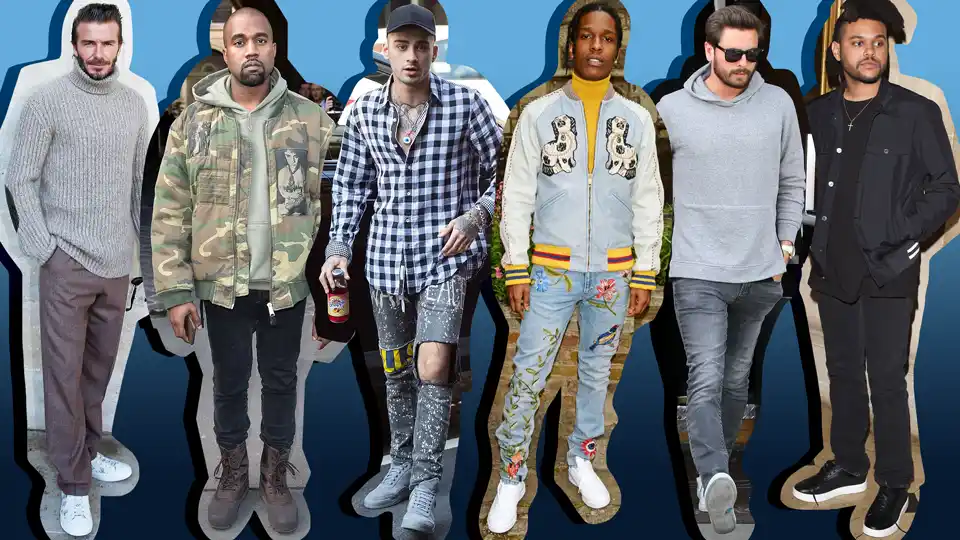Celebrity fashion has long been a driving force in shaping style trends, influencing consumer behavior, and redefining cultural aesthetics. From red carpet glamour to streetwear chic, celebrities have the power to turn a single outfit into a global phenomenon. This blog explores the multifaceted world of celebrity fashion, delving into its historical roots, its influence on the masses, the role of designers and stylists, the rise of social media, and the evolving conversation around sustainability and inclusivity in celebrity style.
Table of Contents
ToggleThe Evolution of Celebrity Fashion
The concept of celebrity fashion isn’t new. It traces back to the early days of Hollywood, when icons like Audrey Hepburn, Marilyn Monroe, and James Dean became synonymous with timeless style. Hepburn’s little black dress in Breakfast at Tiffany’s (1961), designed by Givenchy, remains one of the most iconic fashion moments in history. Similarly, Monroe’s white halter dress from The Seven Year Itch (1955) became a symbol of sensuality and elegance. These moments didn’t just define the stars’ personas; they set trends that influenced wardrobes worldwide.
In the past, celebrity fashion was largely confined to film, television, and magazine spreads. Red carpet events like the Oscars or the Met Gala were the primary platforms for showcasing bold sartorial choices. Designers like Christian Dior and Yves Saint Laurent capitalized on these moments, creating custom gowns and suits that became cultural touchstones. However, the democratization of media in the 21st century has transformed how celebrity fashion reaches the public.
The Power of Celebrity Influence
Celebrities are more than entertainers; they are tastemakers. When Beyoncé wears a custom Balmain gown or Harry Styles sports a Gucci suit with a pearl necklace, their choices ripple across fashion blogs, retail stores, and social media feeds. This influence stems from their visibility and the aspirational nature of their lifestyles. Fans want to emulate their favorite stars, whether it’s through a bold lip color inspired by Rihanna or a minimalist athleisure look championed by Kendall Jenner.
The “halo effect” of celebrity endorsements is well-documented. According to a 2023 study by Nielsen, celebrity endorsements can boost brand sales by up to 4% in the short term, with even greater impact when the celebrity’s personal brand aligns with the product. For instance, when Kim Kardashian wore a vintage Versace dress to a high-profile event, searches for “Versace vintage” spiked by 300% within 24 hours, according to Google Trends data from 2022. This phenomenon, often called the “celebrity effect,” shows how stars can drive demand for specific brands, designers, or even entire aesthetics.
The Role of Stylists and Designers
Behind every iconic celebrity look is a team of stylists, designers, and creative directors working to craft a narrative. Celebrity stylists like Law Roach (who styles Zendaya) or Kate Young (known for working with Margot Robbie and Dakota Johnson) are the unsung heroes of red carpet fashion. They curate looks that align with a celebrity’s persona while pushing boundaries to keep the public intrigued. Roach, for example, has made Zendaya a fashion icon by blending vintage pieces with modern couture, creating looks that feel both nostalgic and forward-thinking.
Designers, too, play a pivotal role. Brands like Chanel, Dior, and Valentino often collaborate directly with celebrities, offering exclusive pieces to ensure maximum impact. The Met Gala, held annually at the Metropolitan Museum of Art, is a prime example of this synergy. Each year, celebrities work with designers to interpret the event’s theme, resulting in unforgettable moments like Rihanna’s 2015 Guo Pei cape or Blake Lively’s 2022 Versace gown that transformed mid-event to reveal a copper patina.
The Social Media Revolution
The rise of social media has amplified the reach of celebrity fashion exponentially. Platforms like Instagram, TikTok, and X have made style more accessible, allowing fans to see what their favorite celebrities are wearing in real time. Unlike traditional media, which relied on curated editorials, social media offers raw, unfiltered glimpses into celebrity wardrobes—whether it’s a paparazzi shot of Timothée Chalamet in a streetwear fit or a selfie from Dua Lipa showcasing a Y2K-inspired outfit.
Influencers and celebrities often blur the line on social media, with stars like Hailey Bieber and Kylie Jenner launching their own fashion and beauty brands. Bieber’s Rhode skincare line and her curated wardrobe of oversized blazers and micro-sunglasses have made her a style icon for Gen Z, while Jenner’s Kylie Cosmetics and Khy clothing line capitalize on her massive online following. According to a 2024 report by Statista, 62% of Gen Z consumers say social media influences their fashion purchases, with celebrity posts being a key driver.
X, in particular, has become a hub for real-time fashion discourse. Fans and critics alike take to the platform to praise or critique celebrity looks, often sparking viral debates. For example, when A$AP Rocky wore a quilted blanket to a 2023 fashion event, X posts ranged from calling it “genius” to “ridiculous,” showcasing the platform’s role in shaping public perception of celebrity style.
Streetwear and Casual Celebrity Style
While red carpet fashion grabs headlines, streetwear has become an equally influential facet of celebrity fashion. Stars like Kanye West, Travis Scott, and Billie Eilish have popularized oversized silhouettes, bold logos, and sneaker culture. West’s Yeezy brand, for instance, revolutionized the sneaker industry, with limited-edition drops selling out in minutes and reselling for thousands of dollars on platforms like StockX.
Streetwear’s appeal lies in its accessibility. Unlike a $50,000 couture gown, a $200 pair of sneakers or a $100 hoodie is within reach for many fans. Celebrities often mix high-end and affordable pieces, creating looks that feel relatable yet aspirational. For example, Bella Hadid’s off-duty style—think vintage leather jackets, baggy jeans, and tiny sunglasses—has inspired countless fast-fashion retailers to replicate her aesthetic.
Sustainability and Ethical Fashion
As the fashion industry faces scrutiny for its environmental and ethical impact, celebrities are increasingly using their platforms to advocate for sustainability. Stars like Emma Watson and Leonardo DiCaprio have championed eco-friendly fashion, wearing sustainable brands or vintage pieces to high-profile events. Watson, for instance, wore a custom Calvin Klein gown made from recycled plastic bottles to the 2016 Met Gala, sparking conversations about sustainable red carpet fashion.
However, the push for sustainability isn’t without challenges. Fast fashion brands, often endorsed by celebrities, contribute to overproduction and waste. According to the Ellen MacArthur Foundation, the fashion industry produces 100 billion garments annually, with 20% going unsold or discarded. Celebrities who partner with fast fashion giants face criticism for promoting unsustainable practices, prompting some to pivot toward ethical brands. For example, Meghan Markle has been praised for wearing sustainable labels like Stella McCartney and Veja, aligning her public image with environmental advocacy.
Inclusivity and Representation
Celebrity fashion is also a battleground for inclusivity. Historically, the industry has been criticized for its lack of diversity, with plus-size, non-binary, and minority celebrities often sidelined. However, stars like Lizzo, Hunter Schafer, and Priyanka Chopra are challenging these norms. Lizzo’s collaboration with Yitty, a size-inclusive shapewear brand, celebrates body positivity, while Schafer’s avant-garde red carpet looks redefine gender norms in fashion.
Designers are also responding to calls for inclusivity. Brands like Savage X Fenty by Rihanna and Chromat prioritize diverse body types and identities, showcasing models of all sizes, ethnicities, and gender expressions. These efforts resonate with younger audiences, who, according to a 2024 McKinsey report, prioritize brands that reflect their values of inclusivity and authenticity.
The Future of Celebrity Fashion
As we look ahead, celebrity fashion is poised to evolve further. Technology, such as virtual and augmented reality, is already shaping how fans engage with style. Virtual fashion shows and digital clothing, as seen in collaborations between celebrities and platforms like DressX, allow stars to experiment with looks that exist only in the digital realm. Meanwhile, the rise of AI-generated fashion designs could redefine how celebrities and designers collaborate.
Sustainability will remain a key focus, with more celebrities likely to embrace circular fashion—renting, thrifting, or repurposing garments. The conversation around cultural appropriation in fashion, sparked by incidents like Kim Kardashian’s “Kimono” controversy, will also push celebrities to be more mindful of their choices.
Conclusion
Celebrity fashion is more than just pretty clothes; it’s a cultural phenomenon that reflects societal values, economic trends, and individual expression. From the red carpet to the streets, celebrities shape how we perceive style, blending aspiration with accessibility. As the industry grapples with issues like sustainability and inclusivity, the role of celebrities as influencers will only grow, making their fashion choices a powerful force for change. Whether it’s a viral moment on X or a headline-making Met Gala look, celebrity fashion will continue to captivate and inspire for years to come.




